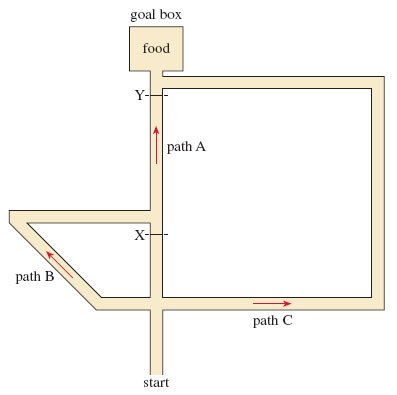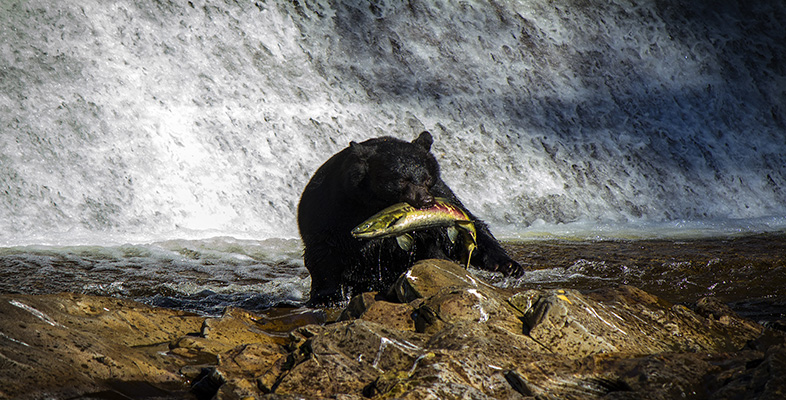8 What makes a successful omnivore?
From what has been said already, there's good evidence that the key physical characteristic of the great majority of omnivores is a non-specialist dentition. What about other aspects of their biology?
Question 11
Question: Many omnivores (e.g. bears, pigs) have a good sense of smell. To what extent do you think that this might be another defining characteristic of omnivores?
Answer
Many carnivores (e.g. brown hyenas) also have an excellent sense of smell and, indeed, so do most herbivorous prey species (e.g. deer, antelopes). Perhaps a good sense of smell is a defining characteristic of mammals in general, rather than omnivores in particular. Even then, since humans don't have a particularly well-developed sense of smell, this does not appear to be a universal feature of mammals.
Apart from their non-specialist dentition, there may be no physical characteristics that are common to all or most omnivores among the mammals. How about behavioural characteristics?
Activity 7
From your viewing of the TV programme and your reading of LoM Chapter 6, list examples of behaviour related to feeding that might be regarded as typical or characteristic of omnivores.
Answer
Examples that you might have suggested are discussed in the text that follows. Tick off items on your list as you meet them.
One striking behavioural characteristic of all omnivores is their opportunism. Omnivores must be prepared to switch rapidly from one food resource that may be running out at the end of its 'season' to another as it becomes available. Thus, grizzly bears switch easily from salmon, to berries, to moths. Furthermore, many omnivores must be taught what is suitable as food and - presumably - what is not (for instance, because it is poisonous). This surely implies quite a good memory and what must be regarded as at least a rudimentary form of 'intelligence'. How do the babirusas featured in the TV programme at 09.30 'know' that a certain sort of clay can neutralise the poisons in their favourite Pangi tree fruits? Much the same question could be asked of comparable behaviour in tapirs, which are herbivorous browsers. The sequence at 12.07-18.35 in the TV programme 'Plant predators' of elephants excavating for minerals in the caves of Mount Elgon makes the same point, this time in the context of mineral deficiency; the photograph in LoM p. 114 implies that early learning plays an important part in maintaining this tradition.
Perhaps related to opportunism is inquisitiveness. Raccoons (and brown rats) apparently investigate any potential new source of food, as you might have surmised from the account of their feeding habits in the TV programme. In this they are greatly aided by their well developed senses of smell and touch, particularly since both operate in the dark to a large extent. Although there are great opportunities to exploit previously untapped food resources, there are also very obvious dangers. Brown rats are extremely cautious about nibbling unfamiliar food and consequently it is remarkably difficult to poison them. They also have the ability to associate particular tastes and smells with unpleasant experiences for at least 12 hours, which helps them to avoid repeating earlier mistakes. On the other hand, brown rats obviously do learn about new situations extremely quickly.
Over the years, scientists who study animal behaviour have conducted many interesting experiments to try to understand such learning. Working with white laboratory rats in the 1940s and 1950s, American psychologist Edward Tolman proposed that rats are able to construct what he termed cognitive maps of their environments. While a cognitive map should not be thought of in literal terms like a street map of London, experimental evidence certainly seems to suggest that the relative locations of relevant objects in the 'real' world are somehow stored in the rats' brains.
In one of his experiments, Tolman used the maze shown in Figure 5. Three paths (A, B and C) lead from the start to the goal box (which contains food). When given a free choice of paths, rats preferred to take path A, this being the shortest and most direct route. After a preference had emerged for path A, a block was placed at location X. Rats then preferred path B, the second shortest route. When the block was moved to location Y, the rats switched without hesitation to path C. Tolman argued that their cognitive maps of the apparatus enabled them to 'see' immediately that Y, which blocked path A, would also block path B but not block path C.

Since those pioneering experiments, a great deal of experimental work appears to confirm that rats possess something akin to cognitive maps of their environments. Of course, it's a far cry from the simple and artificial world of the laboratory to the more subtle and complex world of a mammal's environment, and no doubt these mapping abilities are called upon to a very great degree, in ways that remain unknown to us. But such maps are not unique to, or even exceptionally well developed in, omnivores. More than likely, the hunting carnivores, for example, have the same capacity.
Despite their renowned ability to switch rapidly from one type of food to another, even omnivores can be faced with periods when none of their usual food resources is available to them - for instance, during the depths of high-latitude winters. Under such circumstances, two general coping strategies are available to them.
Both require the deposition of food resources - either externally (perhaps caches in the ground) or internally (as fat) - that can be used to see them through these times of shortage.
The red fox - an omnivorous member of an otherwise carnivorous family - lays down food caches during times of plenty to help it survive harder times. You saw evidence of this in the TV programme (17.00-18.38), in the wake of the fox's raid on chickens. Although this habit - like many other aspects of its behaviour - implies that this species has a sophisticated memory, let's not rush to conclusions. It's possible that foxes simply regularly visit and systematically search 'preferred areas' and/or locate their food caches by smell rather than from memory. There's much the same uncertainty surrounding the use of acorn stores in squirrels.
The second option that omnivores use for overwintering is hibernation. The diversity of hibernation strategies is a useful reminder of just how variable the biology of omnivores has proved to be. You will have encountered the raccoon dog in the TV programme (13.00). It resembles both a raccoon and a dog, but taxonomically it is closer to the latter; it belongs to the family Canidae and the order Carnivora. It eats a huge range of foods, e.g. reptiles, small mammals and fruit. These it eats in great quantities in the autumn, when it can increase its body mass by up to 50% before entering true hibernation, i.e. it lowers its body temperature (Tb) to a few degrees above freezing. The raccoon dog is the only member of the dog family that can hibernate, but it does so comparatively rarely and only in parts of its range and when food is scarce. By contrast, raccoons have, as you've seen, a wide taste in food; they become inactive over the winter months, but are not true hibernators. I've already described a form of hibernation in the grizzly bear; what is not observed in grizzlies (for reasons I explored) is the very substantial drop in Tb typical of true hibernators.
It is appropriate to end, as DA does in LoM Chapter 6, with comments about the reputed success of omnivores. S182_1 Studying mammals: winning design presents a range of possible criteria by which to judge success: number of species, fossil presence in the geological record, geographical distribution. S182_3 Studying mammals: chisellers talks of the high productivity of rodents. Certainly, the family to which brown rats belong (Muridae) is successful by more than one measure. It consists of about 1300 species. As DA points out, the brown (or Norwegian) rat is one of the most widely distributed mammals in the world. To some degree, this enormous range reflects the effectiveness of the opportunistic, omnivorous habit. Further evidence comes from studies of contemporary human societies living in traditional, often hunter-gatherer style. These show just how varied and readily adaptable the human diet can be. The likely ability of our ancestors to vary and improve the quality of their diet and increase the efficiency with which they obtained food and extracted nutrients was probably a major 'driver' for the evolution and success of our own species. With only a small risk of exaggeration, we could say that omnivory made us what we are.
